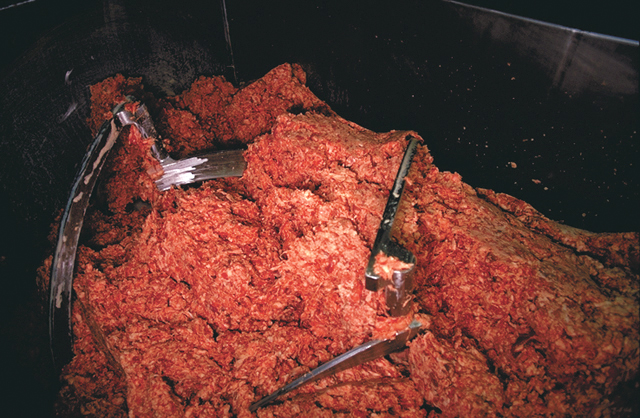Last month was the State Fair of Texas. My friend Kim, who blogs at Running Solo, ventured forth with her family to enjoy the sights, sounds, and even the smells of the Fair. She kindly reported back on the gustatory adventures they experienced:
Healthy eaters are faced with unhealthy choices every time we venture outside our homes for food. This may be why many of us prepare our own meals so often. It is simple to visit the green grocer and read labels in order to acquire the staples we use to prepare our healthy meals. Even so, problems still exist, such as pesticides and additives that we cannot pronounce. The bigger problem occurs when we eat at our favorite restaurants or go to fairs, festivals, or other public events. Unhealthy levels of fat, sodium, and sugar, not to mention calories, are injected, applied, and introduced to improve taste, to entice people to eat more, and thereby to increase revenue. Even the “healthy” choices, self-labeled by the restaurants and fast food joints and then rubber stamped by some official government agency, are rife with unsavory elements that we choose not to consume.
I do my best to select healthy foods when I eat out at restaurants. Usually I do fairly well. I am weak on occasion. However, those weaknesses result from my choice and not by a lack of choices.
My recent trip to the State Fair of Texas, conversely, was a perfect example of a lack of choices hampered by the need for convenience.
The first thing I had to overcome was the onslaught to my senses.
My food mood was enforced early, within minutes of getting out my car, with a multitude of smells, sights, and choices. The heavy, pervasive aroma in the air, a swill of overused cooking fat and cooked sugar, immediately engulfed me. For a relatively healthy eater like me, it bordered on repulsive. But, over the span of a few minutes, my nose became accustomed to the smell and, to my surprise, my stomach started to growl and grumble.
Once inside the fairgrounds, the signs on every booth conspicuously contained the one word for which this fair is renowned: fried. Everything from guacamole, Frito Pie (the recipe which won 2010 Best Tasting award), butter, margarita, okra, potatoes and all food groups in between. It was difficult for me to imagine what fried margarita might taste like, let alone how it is made.

We walked deeper into the fairgrounds. While my son scoped out the arcade games, I surveyed what people were eating. They were proudly sporting foods of convenience, and none of it was fried, but no less unhealthy. A dazzling array of fatty foods on a stick meandered past: turkey legs, corn dogs, cotton candy, sausage with globs of yellow mustard, candy apples. The turkey leg caught my eye for two reasons: not fried and low fat. But, along with every good choice comes a tradeoff. The tradeoff for low fat was high sodium. The Livestrong website states that the total fat for a smoked turkey leg is 4 grams and the protein is 11 grams. However, the sodium is a whopping 570 mg for 80 calories worth of food!
Before the turkey leg I decided to try the Fried Beer, which won the 2010 Most Creative award. So, my son and I ventured back to the front of the fairgrounds and into the food pavilion. We made several passes by the rows of tables to see what people were eating. It was lunch time; conventional food on a stick, eaten solely for convenience, had given way to sit down meals of larger proportions. And most of it was fried. And yet, much of it was not. Pizzas were in abundance, and not just for the children. Another choice that astounded me was salad, mainly the Greek salad. While I understand the choice of pizza for those non- adventurous eaters, the Greek salad option befuddled me. One of the reasons I even venture to a fair like this is to eat food I normally do not consider. Were they eating salad for that same reason or were they healthy eaters, like myself, trying to maintain their diet?

We found the only stand serving Fried Beer and got in the short line. The length of the line should have triggered some trepidation. When the dish finally came, colorfully masqueraded in a red-checkered container, it looked nothing like what I imagined. The pieces resembled miniature ravioli smothered in a gruel-like queso. They were less like pizza dough, more like pretzel dough, which made more sense considering the queso substance they floated in. The beer that squirted from the center upon being bitten was flat and lukewarm, like it had been sitting out in the sun too long on a hot day, and made a small brown stream as it wound its way through the yellow cheese. Basically this was a recipe for loss of appetite. I wish I had gone for the Fried Frito Pie. Next year I will do my research ahead of time.
We headed out of the pavilion and over to the BMX exhibition. My son found his perfect spot and wanted to wait another hour so that no one would take it. Of course, knowing I would be bored out of my mind, I went to find my turkey leg. On the way, though, I came across a lady eating what looked like something sweet and gooey dipped in chocolate. It was a chocolate-dipped Turtle Cheesecake. Yummy. I love cheesecake. I had just found my dessert.

But first for my turkey leg; stalls selling turkey legs were in abundance. With my grand smoked turkey leg in my hand, I made my way back to the exhibition. On the way back I noticed some wire baskets filled with fresh fruit hanging from the awning of one of the vendors. Could it be? Was someone really offering truly healthy choices at this decadent, fat and fried fair?
No, of course not. The fruit was plastic. Can you say bait and switch? However, that same vendor was selling what was called a Fruit Cup. I did not stop to see what it looked like, instead I assumed that is was something like fruit cocktail-in-a-can that you might buy at the local grocery store, loaded with sugar and preservatives.
Sitting with my son, I gnawed, chewed, and picked at my turkey leg. I saw people with funnel cakes and hamburgers, French fries and snow cones. If they were not consuming fatty foods, they were downing sodium and sugar in abundance. In my head, the calorie counter was going berserk. I noticed two school age girls sit down near me happily munching on their burgers. They told me that at school and at home they eat only vegetables. This was their chance to break free and eat something “forbidden”. A few minutes later their parents showed up, apparently unfazed by their food choice. A couple on the other side of me was eating fried guacamole. I asked how it tasted. The woman scrunched up her nose and said it was OK but not what she wanted or expected. Her date offered me his leftovers. Turkey leg still in hand, I politely declined.
Toward the end of the day, I became queasy. I blamed it on the beer(s), but wondered if it was not more a result of eating food I am not used to. Or, it could be from the combination of foods that I ate. Did other fair-goers experience the same thing? It appeared to me that, based on my observation of body mass alone, many people who frequent state fairs do not pay much attention to diet. Fried, salty, and sugary food are staples and the food here at the fair represents an exotic variation of what they already consume on a daily basis.
 I understand that the types of food served at fairs and festivals are not meant to be healthy, but rather tasty and convenient for wandering around. Consumed in moderation, these foods can be liberating for those of us who keep our diets constantly in check. But, beware, over-indulgence can wreak havoc. My nausea lasted most of the rest of the day and I gained over 3.5 pounds. I think I will keep my attendance at fairs to a minimum. I feel too good when I am eating the right foods. Or, at the very least, maybe next time I will smuggle in an apple.
I understand that the types of food served at fairs and festivals are not meant to be healthy, but rather tasty and convenient for wandering around. Consumed in moderation, these foods can be liberating for those of us who keep our diets constantly in check. But, beware, over-indulgence can wreak havoc. My nausea lasted most of the rest of the day and I gained over 3.5 pounds. I think I will keep my attendance at fairs to a minimum. I feel too good when I am eating the right foods. Or, at the very least, maybe next time I will smuggle in an apple.
© Kimberly Bluth 2010, All Rights Reserved.
 Is that not the most adorable kissing booth you have ever seen in your life?
Is that not the most adorable kissing booth you have ever seen in your life? .
.












